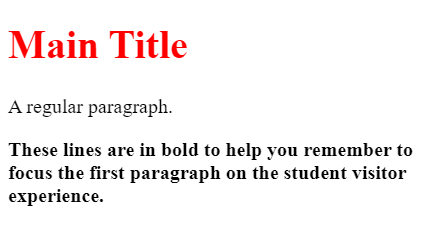HTML Class Attribute
What is HTML?
Hypertext Markup Language, or HTML, is the common markup language used for web page creation and design. It defines a web page's fundamental organization and content, including headers, paragraphs, links, pictures, and lists. HTML marks up material with tags, where a tag in the document refers to a particular element or structure.
HTML pages are composed of nested components, each of which contains content or other elements. A simple HTML document, for instance, may include an element that defines the document's metadata (title, character encoding, etc.) and an element with the page's primary content.
Definition and Usage
The HTML' class' property is used to assign a class to HTML elements, allowing you to apply the same styling to many items on a page. Elements that are assigned to classes can be styled consistently and systematically using CSS (Cascading Style Sheets).
For instance, you may classify many components with the same border, font size, and background color if you wish to design them all. The styles for that class may then be defined in your CSS file, and all items that are assigned to that class will inherit those styles.
The class property can also bridge jQuery or JavaScript methods and a dominant and prominent HTML element.
On the other hand, web developers will implement more features and opt for stylish components instead and add all these in an organized and reusable manner with the aid of the HTML' class' property, which is a vital part of web development as a whole. The best part is when you are ready with an element that has a class, and you can easily employ the CSS to tell it the styles to markup with or the styles that can be used to mark up the components on your website. The spacing and styling then of your website are maintained the same consistently across the website.
This allows you to animate different elements on your website by assigning many different classes to various components and targeting them as you please using the "class" attribute of JavaScript or jQuery. Thus, this makes it an appropriate device for producing appealing and charming personal content.
Advantages
In HTML, the class attribute has the following benefits: In HTML, the class attribute has the following benefits:
- Reusability: Classes help you add a set of situational options or styles to many components. This provides a convenient way to work with stylesheets on a site-wide basis and reuse the code that you wrote.
- Maintainability: Classes are very helpful for making even minor changes to a single element's design or functionality. Just a single edit in your JavaScript or CSS file is enough for that.
- Separation of Concerns: Classes are also used to differentiate and separate the HTML structure when using the webpage's CSS, displays, and JavaScript behavior. That somehow inspires the type of code that is easier to read and maintain.
- Flexibility: For example, a navigation bar serves multiple purposes by Collapsing it to create space if needed or highlighting its content based on the current page. This makes it easy to print interaction and design.
Example:
<!DOCTYPE html>
<html>
<head>
<style>
h1.title {
color: red;
}
p.highlight {
color: purple;
}
</style>
</head>
<body>
<h1 class="title">Main Title</h1>
<p>A regular paragraph.</p>
These lines are in bold to help you remember to focus the first paragraph on the student visitor experience.
</body>
</html>
Output:
 Conclusion
Conclusion
The class attribute in HTML is a convenient tool for web designers that helps to achieve semantic markup and apply the same style and behavior to various features of a page. CSS allows you, for example, to display all text within a class in black, and JavaScript also enables you to apply the same behavior to elements within that class. The user interface is enlightened by holding to uniformity, ease of management, and code reusability, hence improving user experience.
In turn, the class property ensures that a webpage's code is divisible into three parts: the CSS that controls the appearance, the JavaScript that defines the behavior, and the HTML, which will be for the structure. For instance, machine learning analogs allocate tasks to a set role or function, and this process can be expanded to assistive devices by making them accessible.